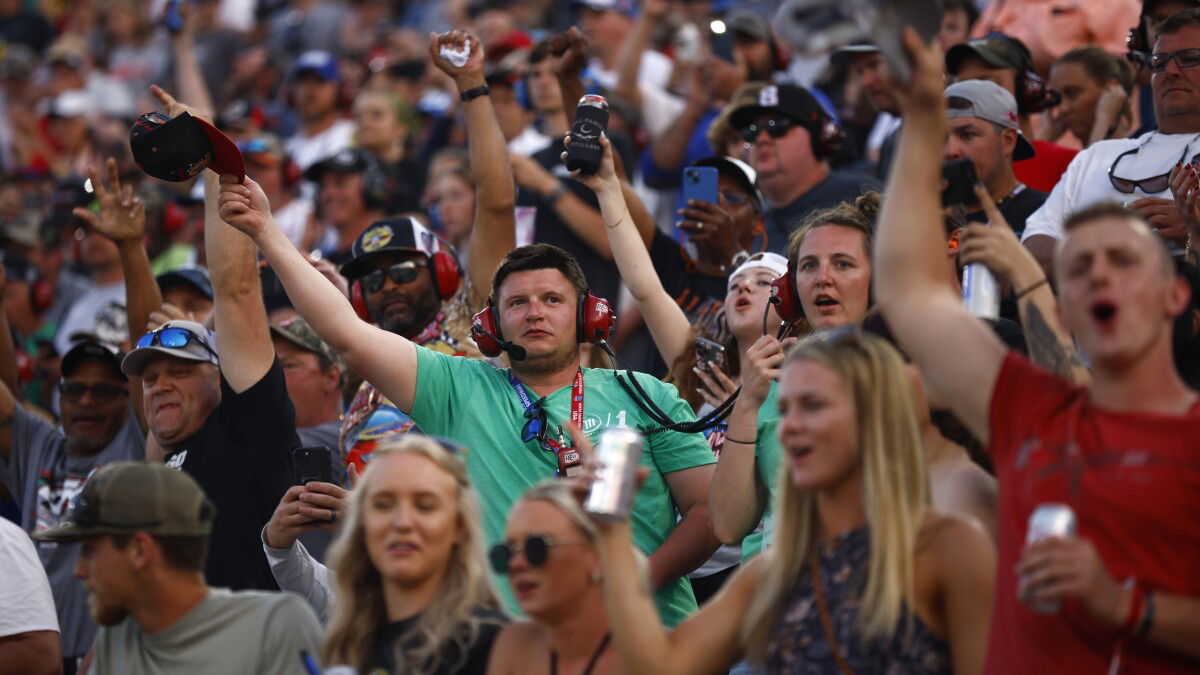
Getty
NORTH WILKESBORO, NORTH CAROLINA – MAY 21: Fans react during the NASCAR Cup Series All-Star Race at North Wilkesboro Speedway on May 21, 2023 in North Wilkesboro, North Carolina. (Photo by Jared C. Tilton/Getty Images)

Getty
NORTH WILKESBORO, NORTH CAROLINA – MAY 21: Fans react during the NASCAR Cup Series All-Star Race at North Wilkesboro Speedway on May 21, 2023 in North Wilkesboro, North Carolina. (Photo by Jared C. Tilton/Getty Images)
NASCAR’s TV ratings have been stuck in a downward spiral, and 2025 has only made the slide harder to ignore. The Cup Series is averaging just 2.52 million viewers per race. This is down nearly 13% from last year, and the playoff races aren’t faring much better. The first four postseason events averaged only 1.56 million, a steep 17% drop from 2024.
Watch What’s Trending Now!
Some tracks, like New Hampshire, saw their audiences shrink by more than 30%. That’s not just a dip; it’s nearly 14 million total viewers gone in just one year. With NFL games dominating Sundays and fans’ viewing habits shifting fast, NASCAR suddenly finds itself fighting for attention. And according to insiders, the problems go deeper than just competition from football.
ADVERTISEMENT
Why NASCAR viewership is declining
As NASCAR grapples with a 13-17% decline in TV ratings and widespread concern over fan disinterest, insiders are dissecting the main reasons behind the slide. “Football, I think, is a major problem for us racing against the football season,” Kraft admits. He acknowledges that overlapping with NFL broadcasts is a perennial challenge.
This challenge becomes more difficult during the ten critical autumn weeks when racing’s core audience is lost to the NFL’s massive draw. Despite suggestions to shorten the season, Allmendinger points out, “We are never gonna shorten, never go to a smaller season.”
A key source of dissatisfaction comes from fans. “31.3% say the playoff format sucks.” Many dislike the elimination style, feeling it’s arbitrary and unpredictable, undermining season-long consistency. The 2024 season is a prime example of this. Despite having a poor playoff run, Joey Logano ended up winning the championship, thanks to his win at Phoenix.
ADVERTISEMENT
View this post on Instagram
The survey further revealed, “31% say the car is awful.” This number reflects criticism of the Next Gen car’s reduced passing, mechanical parity, and lack of driver influence. Just take a look at the April Bristol race, where the race saw just 4 lead changes, with Kyle Larson leading a record 411 laps. NASCAR fans want action, not a parade of cars locked in place with little room for strategy, creativity, or those edge-of-your-seat battles that once defined the sport.
ADVERTISEMENT
Another barrier is accessibility. “14.2% say too hard to find, which is on USA,” Kraft explained, with fans switching streaming and cable channels, losing sight of where races air week to week. This scattered broadcast strategy compounds the problem, further splitting the TV audience and fueling complaints.
In essence, experts believe that fixing the car would solve many problems downstream. However, they warn that a string of unexciting races can break fan habits and drive loyal viewers away permanently. NASCAR must address core product issues, streaming confusion, and intense sports competition. Or, they can risk an era-defining fanbase collapse as TV numbers hit historic lows.
ADVERTISEMENT
2026 NASCAR season set for bold adjustments
The 2026 NASCAR season will see some of the most ambitious changes in recent years, all aimed at revitalizing the sport and stemming the fan exodus. Among the most anticipated moves is the return of Homestead-Miami Speedway as the season finale, a nod to nostalgia and fan requests after several years at Phoenix.
The season will also open with the Clash at Bowman Gray Stadium for the second year in a row, maintaining a grassroots flavor that fans have long advocated. A truly groundbreaking addition is the new street race at San Diego’s Naval Base Coronado, marking the first time NASCAR will compete on an active military installation.
Chicagoland Speedway is being revived after a six-year hiatus. It will be replacing the downtown Chicago street race and further adding to the season’s variety. The All-Star Race will shift to Dover Motor Speedway, its first-ever appearance on the “Monster Mile.” On the other hand, North Wilkesboro, a fan-favorite short track, will return to the Cup schedule as a points-paying event for the first time since 1996.
ADVERTISEMENT
Other notable changes include expanded off-weekends (now up to two during the season), meant to improve team rest and scheduling. Watkins Glen will move to a May slot, allowing for a more diverse early-season schedule. Plus, New Hampshire will lose its playoff slot, transitioning to the regular-season finale stretch.
Taken together, these sweeping adjustments represent NASCAR’s boldest attempt in years to recapture enthusiasm. With a blend of historic venues, innovative new challenges, and a calendar tuned for flexibility, fans are hopeful these changes can reignite excitement and rebuild the sport’s dwindling TV audience as NASCAR sets its sights on a new era.
ADVERTISEMENT
ADVERTISEMENT
ADVERTISEMENT

